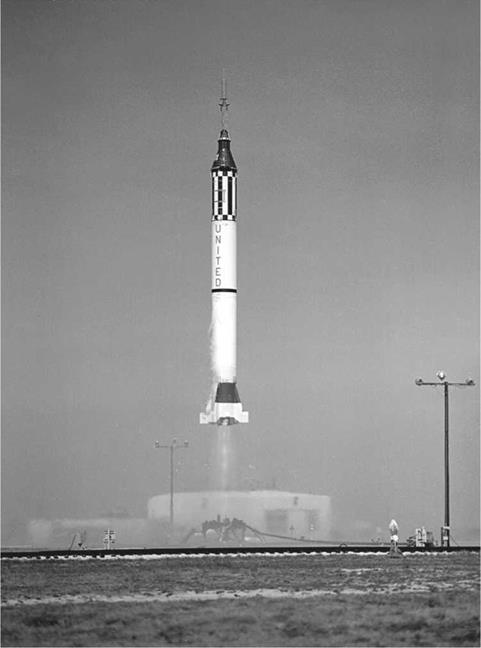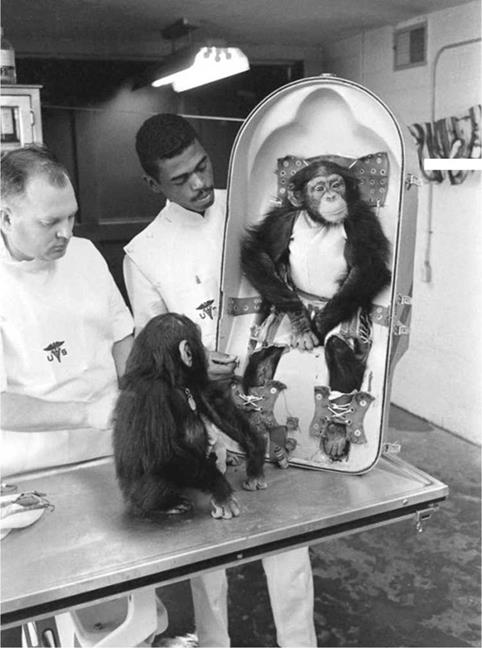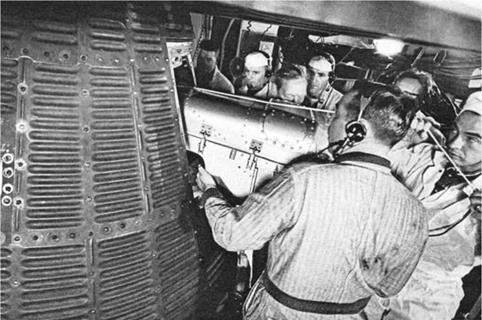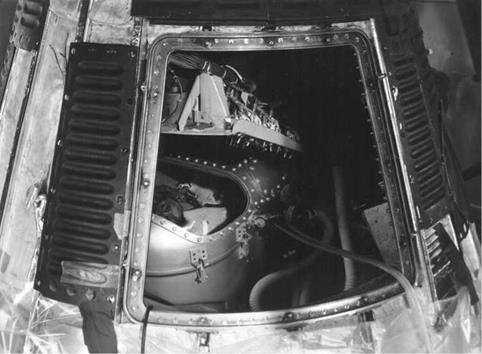GOOD TO GO
In the very early hours of Tuesday morning, 31 January, Ham and Minnie were given a final physical examination. At 1:45 a. m., having been fitted with biomedical recording sensors and dressed in disposable diapers and plastic waterproof pants, both animals
|
Ham seated in his couch with backup Minnie looking on. (Photo: NASA) |
waited patiently as an operational test was conducted of the sensors. They were then dressed in their spacesuits and firmly zipped and strapped into their individual contour couches. Psychomotor stimulus plates were then attached to the soles of each animal’s feet and electrically checked for continuity. Their arms were left free in order that the one who flew the mission would be able to undertake the assigned psychomotor tasks aboard the spacecraft.
As preparations continued around them just after 3:00 a. m., Ham and Minnie enjoyed a prescribed breakfast consisting of some cooking oil and flavored gelatin, half a fresh egg, half a cup of baby cereal, and several spoons of condensed milk. All the tests had determined that Ham remained the better behaved and more animated of the two chimpanzees, and his place in space flight history seemed assured.
The next step in the proceedings was to install and bolt down the lids covering the chimpanzees, following which inlet and outlet air hoses were fitted and the air flow initiated. The containers were then checked for any air leakage, but all proved to be in order. At 5:04 a. m., after all the pre-flight tests had been satisfactorily completed, the handlers were instructed to drive the transfer van over to the launch pad, arriving 25 minutes later. Once there, Ham’s container was switched from the transfer van’s air supply to a portable oxygen supply, then carried to the gantry and up the elevator to the spacecraft level. After being gently inserted and secured into the capsule it was connected to the onboard environmental control system and electrical system. The physiological monitoring of Ham was then switched over to the blockhouse. Hatch closure was completed at 7:10, with an anticipated liftoff time of 9:30 a. m.
|
Ham’s container is carefully inserted into the Mercury spacecraft. (Photo: NASA) |
|
The interior of the spacecraft prior to hatch closure. (Photo: NASA) |
Before the gantry was removed from the Redstone rocket at 8:05 a. m., the transfer van, with the fully prepared backup chimp still aboard, was moved a safe distance away, adjacent to the blockhouse. Still enclosed in her container, Minnie would be monitored up until 30 minutes prior to liftoff, at which time the container with its portable air supply and all her attending personnel would exit the van and move into the blockhouse.
At 9:08 a. m., the count was recycled and the gantry rolled back along its tracks into position. The spacecraft hatch was then opened to cool an overheated electronic inverter which was causing the temperature in Ham’s container to rise. Technicians worked frantically to clear up a number of minor difficulties as concerns grew over a band of stormy weather closing in on the Cape. Repairs were soon completed and the countdown resumed at 10:15 a. m. But as the pad crew were evacuating the gantry its elevator jammed and had to be hurriedly fixed.
Liftoff finally occurred at 11:54:51 a. m. By then, Ham had spent nearly five hours strapped on his back inside the spacecraft. Two Mercury astronauts observed the ascent from the air, with Deke Slayton and Wally Schirra circling the launch area in F-106 jets.

Liftoff of the MR-2 mission. (Photo: NASA)













